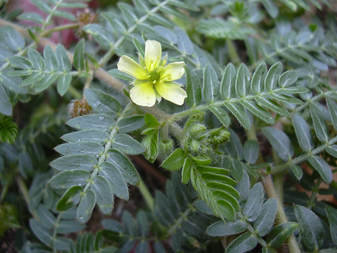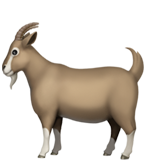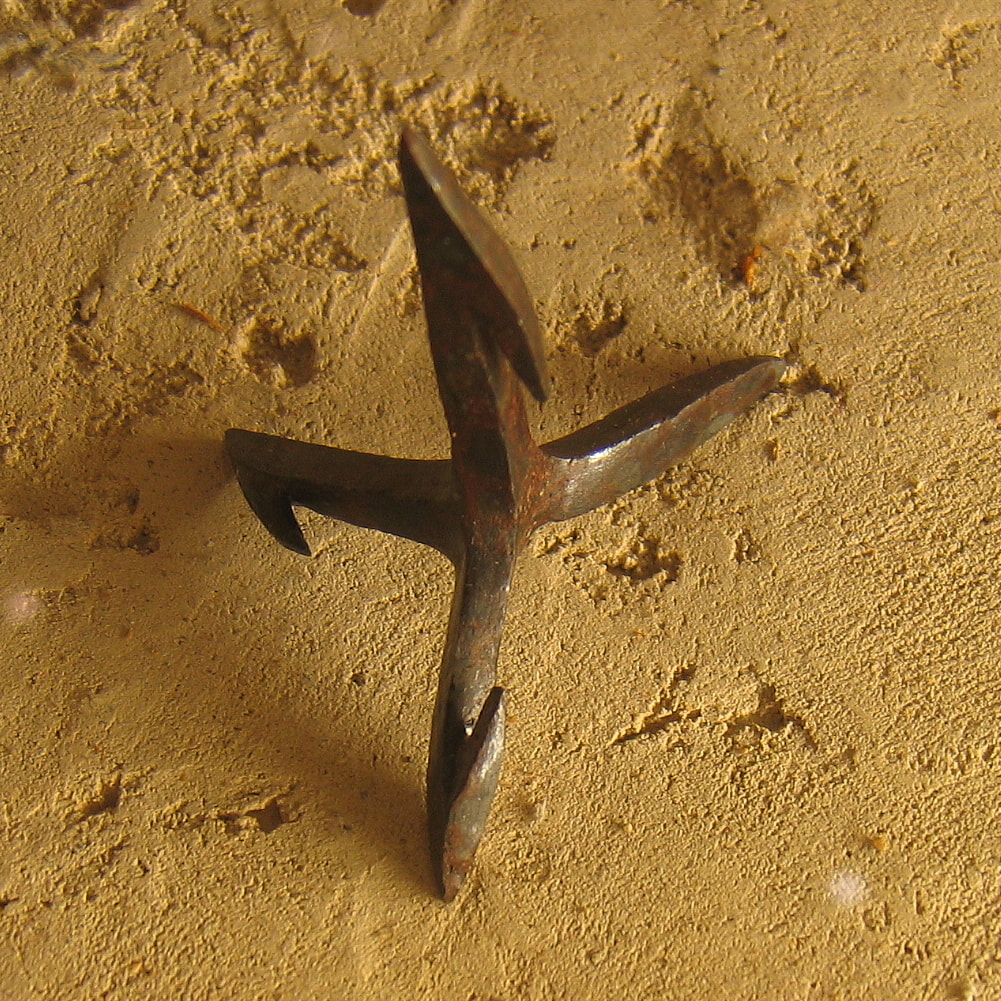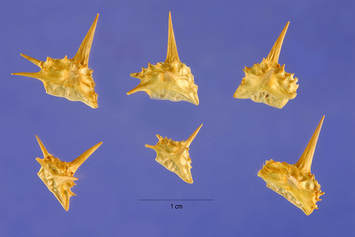 Tribulus terrestris Image by Forest and Kim Starr. Courtesy of: http://www.starrenvironmental.com/imageusepolicy/ Tribulus terrestris Image by Forest and Kim Starr. Courtesy of: http://www.starrenvironmental.com/imageusepolicy/ Not long ago, there appeared all over my Twitter a goat emoji. This was usually applied to posts about phenomenal athletes (Lebron James, Tom Brady (gag), Diana Taurasi, Serena Williams, etc). For the longest time I couldn’t figure out what it was all about. I finally learned that GOAT stands for Greatest of All Time. These athletes are usually powerful because of their stature (for their position). They are BIG and STRONG and thus...powerful. Here is an example of this kind of conversation. And certainly in the world of sports, especially SOME sports, big means power. But I’ve also come to realize over the years (as trite as it might seem) that power doesn’t require size or girth at all, and in some of the most powerful entities in the world, indeed the real GOATs, are actually pretty tiny. I’m thinking here of ants and viruses and things of this ilk. As I write, we are being visited by one of those tiny GOATs courtesy of a monsoon storm. I look at the tiny drops of water dripping onto the parched earth and think about how much power that singular molecule holds. I can almost hear the plants gulping as much as they can from the earth as the tiny soil particles hold the moisture for too brief a time. In Tucson, when those droplets arrive, they have the power to utterly transform an entire city’s attitude. Now that is power! My social media groups like “Tucson Backyard Gardeners” blow up with videos and pictures and exclamations about the storm. Gloating reports come from the West side of town while the South and East might be decrying the absence of the life giving rivulets. I suspect in some places rain makes people depressed or they become immune to it, but not here. “My plants are so happy” will rejoice a friend on Instagram. “The Rillito [one of our local...usually dry...rivers] is flowing!!” will report someone else on Facebook. I have been known to share a video or two of my street turned lazy stream or rushing torrent (drainage isn’t really a thing in central Tucson). The Sonoran Desert only receives about 12 inches of precipitation per year, and the monsoon season accounts for almost ½ of that. As a result, the desert comes alive this time of year rejoicing, I imagine (or maybe I’m just projecting), in the fact that it has survived the hellish early summer of May and June. Wildflowers make a second appearance. The bugs decide it’s time to take over (especially our backyard residents the mosquitos, cockroaches, and Black Widows - really the desert is awesome), Octatillos begin to photosynthesize with their newly minted leaves, and Colorado River Toads croak their poisonous arrival above ground. The night of the toads’ emergence must be quite the party as these amphibians tend to mate on one night only just after a significant rain (an inch or more). These toads can grow to be 7 inches long, and they have a skin toxin that is strong enough to kill a decently-sized dog. Despite their name, they are in steep decline in western Arizona (where one would find the actual Colorado River). But on that one night, after those tiny drops of rain accumulate enough to dampen the desert to the toads’ preferred level, one can hear them “gettin’ busy” as their mating calls fill the night air. After that one romantic evening, the female toads deposit upwards of 8000 (EIGHT THOUSAND) eggs and then go back to whatever it is they do the other 364 days of the year. Ah -- nothing like a blog about toad sex, right? Anyway...I digress. Other life returns to the quiet desert in the monsoon-inspired late summer. And as the desert starts its turn toward its version of autumn, fall hatchling lizards manifest, barrel cacti bloom, and the Texas Rangers bathe the city in purple grandeur. As the weather turns colder elsewhere in North America, the Sonoran Desert maintains its average temperatures in the 90s so hummingbirds and other migratory birds start to arrive at the feeders with more frequency, harvester ants frantically gather their treasures, and the endless barbed plants put out their sticky fruit to ensure (more than) adequate transportation toward new places for propagation. (1) This time of the year, you’d think Chinle would love her walks more than usual. But for a dog with tender paws and a general life-long intolerance to heat (she is a black Labrador, for pete’s sake), the humidity and the intensive efforts of prickly plants to make their getaway from their overbearing parents transform monsoon season from miraculous to treacherous. Which brings me to the real point of this blog...the inspiration for all this small but mighty/GOAT discussion. I think I have found the GOAT of GOATs. The most powerful entity on earth may just be one that is so tiny and so unassuming that most folks are unaware of its presence. This is the Lebron James of the plant world, and you likely have no idea it’s there until it’s REALLY there. This plant makes its presence known right around August and September here in the Sonoran Desert and is appropriately known as the GOAThead (all cap emphasis mine). WARNING: In what follows, there may be some language not suitable for those with delicate eyes. But if you’ve ever stepped on one of these “seeds” in your bare feet, you will recognize the language as you have likely uttered it yourself. Tribulus terrestris, also known as caltrop, puncturevine, goathead, devilsweed, pieceofshit, and evilbastard, can (and does) survive anywhere and everywhere in North America. It grows in parking lots, dirt lots, vacant lots, really any lot you can imagine. And when conditions are right, like this year in Tucson, it grows A LOT. It is, at first glance, almost a charming plant. It has fern-like leaves and lovely little yellow flowers that appear in profusion...right after those powerful little drops of rain visit our fine desert. Folks who are unaware of what this son of a bitch has in store for them, ignore the plant allowing it to nearly take over the cracks and crevices of their sidewalks and yards. Within a month or so, the pretty yellow “wild” flowers have transformed into the true meaning of the Latin name, which refers to a caltrop - a three-pronged weapon used in premodern European warfare to stop, well, everything and everyone it came in contact with. This bloody plant is named after AN F*ing WEAPON, people!! The “caltrop” of the puncturevine is similarly powerful. It will stop a tough dog in their tracks as they yelp and looking imploringly up at someone with thumbs (or if they are a bizarre, somewhat masochistic Husky, they will use their teeth to remove the weapon of mass destruction and eat it). The GOAThead will pop a bike tire before you can yell “shit!” It will penetrate a human foot so deeply one can almost taste it. It will render a horse lame and can even choke a bunny. A BUNNY! Supposedly the damn things can be brewed and made into diuretics and may even be boosters of testosterone (toad sex anyone?). But when it’s all said and done, the most the invasive GOAThead does is ruin lives. Imported from Europe (or maybe Asia), this jackass of a plant does no discernable good but rather causes pain and anger and at this, it has no rival. It is the GOAT(head)! The plant is such a nemesis that it is listed by the United States Department of Agriculture (and state ag departments) as a(n) (ob)noxious weed - meaning WE SHOULD KILL THE BASTARDS! In 1961, United States Department of Agriculture introduced a biological control agent to do just that. Microlarinus lareynii is a seed eating weevil that feeds only on the seed pods of the GOATheads. It’s a tricky little devil, the weevil (as is true for most biological control mechanisms), but when it works, it works. You can even go buy some for yourself...for example through this website (I’m not endorsing the site, just showing you that holy cow, this tiny little “thorn” is so powerful it has inspired entire websites and government plots to destroy it). The Colorado state government even hosts its own “Request a Bug” site -- so….ya know...have at it. This year, in Tucson, seems to be a banner year for the pieceofshit. They are everywhere...even finagling their way into the “grass” in the parks in central Tucson. My neighbors seem oblivious to its presence which is infuriating to me and makes me not as friendly as I should be. It makes our dog walk feel like a sojourn through a minefield. And it mocks us in its prolific ability to adapt and reproduce. I can almost see the codwaller flipping me the bird every time I dig one up. It KNOWS its seeds stay viable for 3-4 years and it KNOWS there is no chance I got them all because they sneakily blend in perfectly with the dirt around them. So what can be done? The government could help import some of them thar weevils...but let’s just say the Tucson city government is not the USDA of 1961 (topic of another blog? hmmmm). My neighbors could begin to wake up and realize there is an enemy amongst us (and it isn’t JUST the Russians). We could stay inside for 3 months and just wait until December when maybe the caltrops have mostly become wedged in the ground. Or we could just suck it up and accept that the small have great power, and we live in a world where drops of rain inspire lots of toad sex, and the real GOAT seems to be a tiny tripod-shaped seed pod that has flummoxed entire armies and one sweet 9-year old labrador retriever. And lest you think the monsoons down here in Tucson are all rainbows and butterflies….beware: the power of the GOAT(head). 1) For a great resource on all things Sonoran check out the Arizona Sonora Desert Museum which just celebrated its 66th birthday!
0 Comments
Leave a Reply. |
Archives
July 2020
Categories |
Proudly powered by Weebly



 RSS Feed
RSS Feed